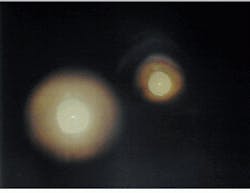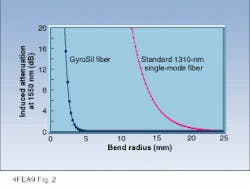Improved manufacturing lowers cost of single-mode fiber
Improved manufacturing lowers cost of single-mode fiber
Consortium develops a high-performance, low-cost optical fiber for demanding applications.
James P. Clarkin
The design and production of a high-performance, low-cost, single-mode fiber for gyroscope coils is a critical aspect of developing interferometric fiberoptic gyroscopes (IFOGs) for military and commercial aviation applications. To address this challenge, the US Defense Advanced Research Projects Agency (DARPA), as part of its ManTech (manufacturing technology) program, established a program to create an advanced-design, navigation-grade, fiberoptic gyroscope system that could be manufactured at reduced cost.
Fiberoptic gyroscopes were originally designed and manufactured for US military applications, and present costs are not competitive with other technologies. The philosophy behind the ManTech program is to encourage companies to optimize military technology within acceptable cost parameters for high-volume production. Development of high-performance, low-cost fiberoptic gyroscopes was unlikely without ManTech support. To this end, Honeywell Industries (Phoenix, AZ) was awarded a contract to develop a pilot production line and demonstrate the ability to manufacture a navigational-grade gyroscope scalable to a 10,000-axes-per-year production rate at a cost of $1500 per axis.
Honeywell adopted a depolarized gyroscope design using a nonpolarized single-mode fiber as opposed to previous fiberoptic gyroscope designs that used a polarization-maintaining single-mode fiber. The nonpolarized single-mode fiber is significantly less expensive, thereby reducing the overall system component cost. In addition, nonpolarized single-mode fiber is more closely related to the industry-standard telecommunications single-mode fiber, which increases the potential for cost reduction. As part of the two-year program, Honeywell formed a consortium of companies to contribute to the redesign effort and selected SpecTran Specialty Optics Company (Avon, CT) to design and manufacture the new single-mode optical fiber, GyroSil.
The fiberoptic gyroscope design requirements include a precision-wound coil of approximately one kilometer of single-mode optical fiber. Three coils are used to complete the full gyroscope, one for each axis. Each coil is approximately
2 in. in diameter and conforms to many performance requirements (see table on p. 140). The coil must demonstrate stable, consistent, and predictable optical and mechanical performance through a temperature range of ?54!C to +92!C. The single-mode fiber must have very low bending loss at
1560 nm. The overall coil size and weight requirements dictate an extremely small (80 ?m) cladding diameter fiber. Finally, a balance is needed between bending and coupling losses to achieve the optical system budget requirements.
To be cost-effective, the cost of the fiber had to be reduced from more than $1.00 per meter to less than $0.20 per meter (if manufacturing 10,000 km per year). SpecTran Specialty Optics reviewed all of the steps involved in the fiber manufacturing process, looking for opportunities to cut costs while still satisfy the system requirements. These steps included preform manufacturing, fiber drawing, coating selection, and the process/product flow. The manufacture of this type of specialty fiber was divided into two processes?glass preform fabrication and optical fiber draw?and both were analyzed for their cost-cutting potential.
In the preform fabrication process, the goals were to reduce the cycle time (the time it takes to manufacture the preform) and to increase the overall preform size. Improving these processes increases the batch size and reduces the overall fabrication time per preform. An additional goal in core and clad processing is to improve the dimensional symmetry of the fiber to maintain a consistent profile and achieve the required optical parameters?mode field diameter, cutoff wavelength, and core/clad concentricity?with minimal processing. Improving dimensional symmetry was essential to minimize polarization effects in the fiber due to coiling.
Time-saving steps
In the fiber draw process, the main cost-saving parameter is cycle time, including both setup time and line speed. There are many design considerations for the finished gyroscope, however, that depend on the fiber draw process, in particular the physical properties and dimensions of the coating. Honeywell directed Spectran to evaluate and determine the correct coating based on material size and dimensional tolerances. The modulus of the selected coating must remain low enough (<3000 MPa) at ?54!C that attenuation would meet the project?s power budget requirements. The coating also must show no hysteresis in multiple temperature cycles.
Reducing the coating diameter to a target of 130 ?m is another major design feature necessary for the fiber to fit on the gyroscope coil and to reduce the overall magnitude of the thermal effects due to changes in the physical properties of the coating. Although the exact nominal diameter of the coating is not critical, the variation of the coating diameter must be maintained within ?2 ?m in a 1-km length of fiber to ensure winding uniformity within the gyroscope coil.
The final cost-saving area is the reduced handling time in the process/product flow, including geometry and optical measurement, prooftesting, and winding to the shipping spool. The approach in this area uses industry-standard equipment with modified fixturing to accommodate the smaller-diameter GyroSil fiber.
Cost-reduction program
The development team worked out several specific methods to reduce the cost of the fiber for the fiberoptic gyroscope. To reduce the preform cycle time and achieve consistent uniformity, a hybrid vapor deposition (HVD) process?which is an outside process?is used. The HVD process offers inherent dimensional symmetry, a characteristic highly desirable in the final fiber and well suited to high-volume manufacturing.
The process enlarges the size of the glass core, which is the germania-doped
section of the preform. The larger core is reduced dimensionally through elongation, a process that spreads any non-
uniformities out over extended lengths
of fiber. This elongation reduces the actual variation observed and results
in high uniformity within each 1-km fiber length.
The preform cycle time is further reduced by increasing the silica deposition rate by approximately 60%. This reduction is accomplished through process chemical delivery upgrades that enlarged the volume flow rate of the silicon tetrachloride deposition material impinging on the preform.
In another cost-reducing measure, the preform size is doubled, which improves fiber uniformity down the length of the preform. The enlarged preform also increases the overall batch size at fiber draw and this, in turn, reduces the setup time required per lot. In addition, the fiber drawing line speed is accelerated by 40%.
To reduce the fiber measurement cycle times, the fiber mounting equipment, coating stripping, and fiber-end cleaving equipment is modified to accommodate the new fiber?s target 130-?m coating with 80-?m cladding. This change allows the small fiber to be tested at cycle times comparable to testing standard 250-?m coating, 125-?m cladding single-mode fibers. In addition, the consistency of the GyroSil fiber allows valid lot testing at high production volumes (see Fig. 1).
To ensure low bending losses after coil winding, the base fiber is screened for high bending loss before additional costs are incurred in the coil winding and termination processes. A bending-loss test was developed for this purpose; however, the GyroSil fiber has demonstrated such characteristically low bending losses that the test has been eliminated from the spooling process (see Fig. 2). Fiber can be wound directly onto the shipping spool, saving the time and cost of this extra process step.
Finally, a series of coating materials were reviewed for physical characteristics and application properties related to the glass fiber. Four coatings were selected and evaluated online for coating diameter and consistency during fiber draw, followed by coil winding and coil optical performance over the required temperature range. The selected coating balances performance at the high and low ends of the ?54!C to +92!C temperature range. It demonstrates a very high degree of uniformity (see Fig. 3). In addition, the fiber drawing process exhibits exceptional control, holding the glass cladding diameter to 80 ?m with a standard deviation of 0.29 ?m and no observed proof breaks at a 100 kpsi proof test value.
Derivative applications
As noted above, the final objective of the DARPA/ManTech program was to reduce the cost of the fiber to less than $0.20 per meter in production quantities of 10,000 km or more per year. The manufacturing and design improvements successfully achieved this objective. In addition, the fiber produced indicates a high degree of control and uniformity. The program is currently conducting a prototype demonstration of the completed depolarized gyroscope, which is scheduled for completion in mid-1998.
Because of the success of the program and the demand for similar single-mode fibers in other applications, GyroSil fiber will be sold commercially. Direct derivatives of this fiber also are finding use in the aerospace market for a variety of applications requiring small-diameter, single-mode fiber with low-bending-loss characteristics. GyroSil or its derivatives are being used as payout fiber in tethered/sensored decoys, signal-delay coils, intruder identification, and fiberoptic guided-missile applications. Low bend attenuation, high tensile strength, small size, and operation over a broad temperature range make this fiber useful in stringent single-mode military and commercial applications. o
FIGURE 1. SEM image illustrates size difference between standard 125-?m fiber (left) and GyroSil 80-?m fiber (right) developed by a DARPA program to lower cost of manufacturing fiberoptic gyroscopes.
FIGURE 2. Bending loss in GyroSil fiber is consistently low compared to standard telecommunications single-mode fiber.
FIGURE 3. Coating diameter variation falls well within the ?2-?m specification for high-performance optical fiber for gyroscopes, with a standard deviation of 0.13 ?m on an average diameter of 134 ?m over a draw of more than 50 km.




